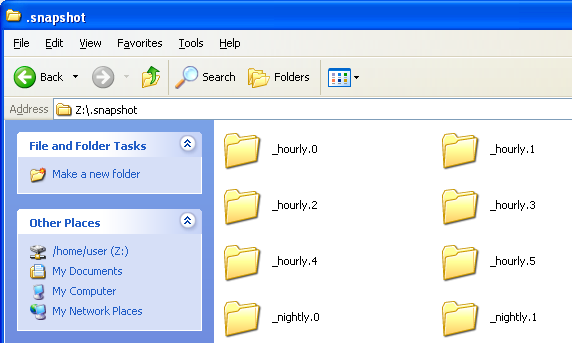
| Storage Area | Backup policy | Snapshots |
| Home directories (/home/username) | Weekly backups, with daily incremental backups. These tapes are kept onsite for four weeks. Every four weeks a special full backup of home directories is done and sent offsite; these tapes are kept for eight weeks | 6 hourly, 6 daily and 8 weekly |
| Data directories and shared data directories (/data/username or /data/SharedDir) | NOT BACKED UP. Users should back up any irreplaceable data to their own local systems. | 2 nightly and 1 weekly. Very large /data directories may contain only one nightly snapshot. |
| Buy-in storage | As agreed in the storage buy-in agreement. | As agreed in the storage buy-in agreement. |
A 'snapshot' is a read-only copy of the data at a particular point in time.
If you inadvertently deleted a file, you can try to restore it yourself from an existing snapshot, using the instructions below. If the file had been present in your directory when a snapshot was made, you will be able to see the file in the .snapshot and copy it back into place.
Note that .snapshot directories are 'hidden'. They won't show up in an 'ls'. .
Log into your helix account, go to your home directory:
% cd
Assume that you are going to restore the files in your home directory, type:
% cd .snapshot % ls Hourly.2016-05-11_1700 Hourly.2016-05-12_1400 Nightly.2016-05-12_0010 Weekly.2016-04-24_0010 Hourly.2016-05-11_2000 Nightly.2016-05-06_0010 Weekly.2016-03-20_0010 Weekly.2016-05-01_0010 Hourly.2016-05-11_2300 Nightly.2016-05-07_0010 Weekly.2016-03-27_0010 Weekly.2016-05-08_0010 Hourly.2016-05-12_0500 Nightly.2016-05-09_0010 Weekly.2016-04-03_0010 Hourly.2016-05-12_0800 Nightly.2016-05-10_0010 Weekly.2016-04-10_0010 Hourly.2016-05-12_1100 Nightly.2016-05-11_0010 Weekly.2016-04-17_0010
Select the time frame when your files still existed. There are 3 time categories: hourly, nightly, and weekly. Each category has several snapshots with timestamps as part of the directory name (e.g. Nightly.2016-05-06_0010 is a snapshot taken on May 6, 2016, at 6 am.)
Go to selected directory:
Then find the file(s) you are interested in and copy them to your current home directory:
If you have your directory mounted on your desktop Windows machine (see http://helix.nih.gov/Documentation/transfer.html), you can also recover files:

Snapshots for data directories are done less frequently than for home directories. Typically there are two daily and two weekly snapshot available for all data directories. The commands required for accessing the snapshots vary slightly depending on the storage system on which a data directory is located
To determine the storage system on which your data directory is located, run the following:
A linked path starting with "/vf/users" indicates that the data directory is on the VAST storage system. A linked path starting with "/gs" indicates that the data directory is on a GPFS storage system and those starting with "/spin1" are on the NetApp storage system.
If the data directory is on a GPFS or NetApp storage system:
The snapshot directory names for GPFS filesystems have a format of daily.‹timestamp› and weekly.‹timestamp› where ‹timestamp› is the date/time when the snapshot was created. Those on the NetApp system have a format of _nightly.0 and _weekly.0
To recover data directory files from snapshots, go to the snapshot area of your data directory (or shared data directory):
Select the time frame when your files still existed based on the snapshot filename formats descibed above and go to selected directory. For example:
Find the file(s) you wish to recover and copy them to your data directory:
If the data directory is on the VAST storage system:
To recover data directory files on the VAST storage system, go to the global snapshot directory for the VAST system:
The snapshot directory names for the VAST storage system have the following format: daily_‹timestamp› for daily snapshots and weekly_‹timestamp› for weekly snapshots where ‹timestamp› is the date/time when the snapshot was created.
Run a 'ls' to list the available snapshots.
Select the time frame when your files still existed based on the snapshot filename formats described above. For example, go to selected directory:
Go to the directory corresponding to your username (or the shared data directory):
Find the file(s) you wish to recover and copy them to your data directory:
Note that data directory snapshots are updated every weekday and may be temporarily unavailable while an update is in progress.